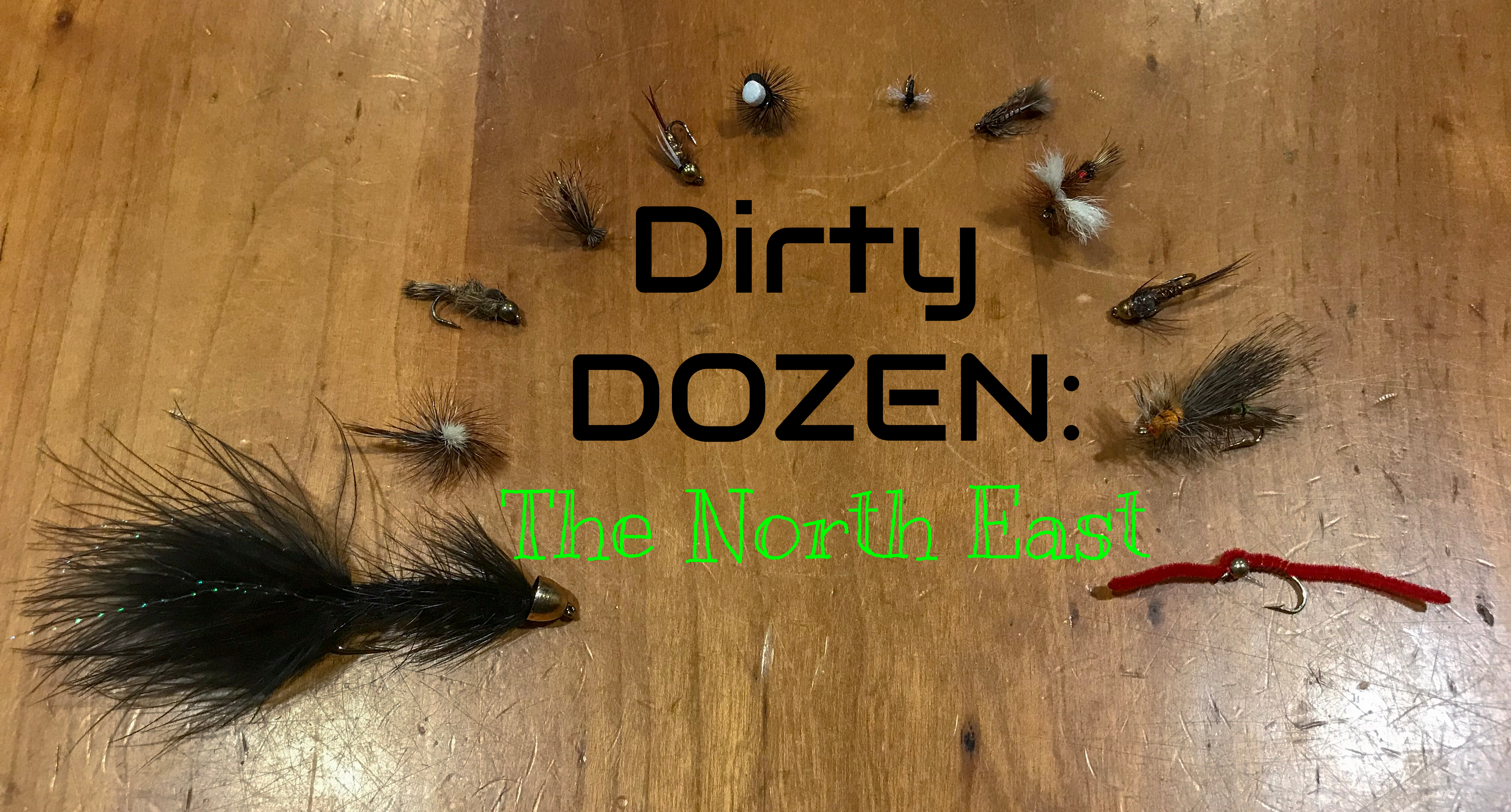So you’re looking for a straight to the point, no B.S. way to catch trout in the North East? Well, you’ve come to the right place–these are the “Dirty Dozen” flies you need to successfully fool and catch trout in the North East.
You can get all of these essential flies and more with a monthly Postfly subscription.

Dry Flies:
Mayfly imitations: (Parachute) Adams, Light Cahill, March Brown, Hendrickson, Grey Fox, Blue Wing Olive—choosing which pattern all depends on what mayflies are hatching at the time but these patterns should keep you covered for any situation.
Royal Wulff: An attractor pattern and absolute trout candy, the Royal Wulff is a classic imitation of mayflies and terrestrials alike. I don’t know why, but even fish that have seen 1,000 flies hit this pattern with a recklessness that I will never understand.
Stimulator: One of the staple attractor flies out there, the Stimulator is killer when there is a large stonefly hatch or nothing hatching at all. Additionally, because of its “bugginess”, it also makes for a great prospecting fly. This fly is very dynamic because it can resemble many things while imitating nothing in particular.
Deer Hair Caddis: Created by a Pennsylvanian fly tier, the Caddis is a great searching pattern and imitates caddis hatches as well as small stonefly hatches. Dead drift it, skate it, do whatever with it, it will catch fish.
Foam Ant/Hopper: Especially during the summertime, and, if you find yourself blue lining, some of those aggressive small water fish love foam ants and smaller sized foam hoppers. They are a blast to fish and you will catch fish of all sizes.
Smaller patterns: Like the mayfly imitations, these smaller patterns are not necessarily attractor patterns, but they cover the most finesse-y situations. Trico’s, Griffith’s gnats, and General T’s perfectly imitate teeny-tiny midges, mayflies, gnats or ants and can be the difference between zero fish and a great day when those trout get finicky/picky.

Wet Flies:
I prefer to use bead head nymphs (I personally don’t like to mess with split-shot when I don’t have to). Don’t forget to experiment with dry-dropper rigs as they can be very effective, as well as euro-nymphing.
Prince Nymph: An excellent nymph that imitates mayflies or stoneflies and can be used as an attractor pattern.
Hare’s Ear (Flashback): A staple that should be in any fly fisherman’s box, the Hare’s Ear is an effective pattern throughout the year because its various ways of being tied (fat, slim, bushy or sparse), cover a broad spectrum of prey/aquatic life that are active in every season—from scuds to mayfly nymphs to caddis larvae.
Pheasant Tail (Flashback): One of the most popular nymph patterns, the pheasant tail is also known to imitate a large variety of aquatic insect larvae—specifically mayfly larvae.
San Juan Worm/Squirmy Worm: Highly debated as not actual fly fishing, the fact remains that every river is plentiful with worms. This fly imitates those worms just like a streamer may imitate a sculpin. Worm flies work excellently after floods, heavy sustained rains and stained water as many types of worms, both terrestrial and aquatic, are abundant and trout love ‘em.
Emergers: Possibly the most frustrating situations is just not being able to figure out what the fish are feeding on. If you find yourself throwing every dry fly in your box at rising fish to no avail, you may be dealing with fish feeding in the surface film layer where nymphs and pupae get trapped before emerging. This situation is where throwing a dry fly with an emerger off the back can be extremely effective. Typically, I will use the same patterns I’d use for nymphs, but without a bead. There are also several soft hackle emerger patterns such as Sulphur soft hackles, Holy Grail Caddis emergers or the Bird’s Nest Sulphur emerger that work wonders.
Wooly Bugger: There’s not much to be said about the wooly bugger, it is a classic streamer pattern that can imitate any benthic creature like a minnow, crawfish or leech. The success of wooly buggers is unmatched by any other streamer pattern; they can catch fish in fast or slow water, lakes or streams, in dirty or clear water. Favorite colors include white, black and olive.

This read was worth your time because now you aren’t left guessing and having to do any extra research. Now get out there, quit wasting time and catch some fish!
https://postflybox.com/blog/2018/10/18/invest-in-what-you-love-equity-crowdfunding-and-why-were-doing-it/
https://postflybox.com/blog/2017/05/10/5-more-trout-flies-you-should-carry-at-all-times/
https://postflybox.com/blog/2017/04/17/the-5-saltwater-flies-you-should-carry-at-all-times/
https://postflybox.com/blog/2017/04/12/the-5-bass-flies-you-should-carry-at-all-times/




Hi, in addition to monthly deliveries, why not sell the “dozen must have flies” as a package purchase?
Thanks for the comment, they’re in the works!